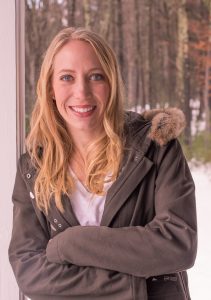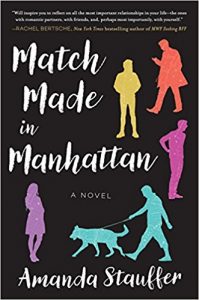When Truth Is Stranger Than Fiction . . . and Then Becomes Fiction
 My book began as a list of men’s names scrawled on the back of a cocktail napkin. I was at drinks with friends, relating the details of my latest Match.com dates. I’d been dumped before the first kiss, donned full HAZMAT gear on a third date, and, been set up with another date’s mom. I’d fallen—hard—for a tattooed folk singer-turned-investment banker, received intel from an undercover federal agent, and was so inspired and energized by this colorful cast of characters and all that they taught me, I sometimes felt like I was living in a rom-com.
My book began as a list of men’s names scrawled on the back of a cocktail napkin. I was at drinks with friends, relating the details of my latest Match.com dates. I’d been dumped before the first kiss, donned full HAZMAT gear on a third date, and, been set up with another date’s mom. I’d fallen—hard—for a tattooed folk singer-turned-investment banker, received intel from an undercover federal agent, and was so inspired and energized by this colorful cast of characters and all that they taught me, I sometimes felt like I was living in a rom-com.On that napkin, we charted out the highs, lows, and takeaways of my time dating each of these men. When we were done, I marveled at the ready-made arc before me, and at the significant themes and messages I’d annotated in the margins. I went home and stayed up until 10 a.m.transcribing that fateful napkin and constructing a 30-page outline for the book.
When I finished the manuscript a year later, I phoned a few authors for advice. What now? While they were all exceedingly generous with query tips and immensely supportive, each advised I pitch it as fiction. They knew fabulous authors with robust credentials who couldn’t land agents or book deals because they lacked the dreaded “P” word (platform). As one without a single tweet or ‘gram to my name, with a master’s degree in a completely unrelated field, I didn’t stand a chance.
I went ahead and drafted my query letter, but I kept flipping the final word of the introductory paragraph, back and forth between “women’s fiction” and “memoir” and “women’s fiction” again. I built a query list that only included agents who repped both women’s fiction and memoir. I consulted every book, blog, and website I could find for additional guidance and data.
The takeaway was clear: without 10,000 followers, my memoir wouldn’t sell.
Still, I couldn’t shake the feeling that this story needed to be told as memoir. So many authors have wild, vivid imaginations. Wouldn’t this story be considerably less interesting if it were a figment of my imagination? Wasn’t the main appeal that these diverse and fascinating men actually exist and are walking the streets of Manhattan, and the reader might wind up on a date with one of them next week? As fiction, wouldn’t it lose its voyeuristic appeal?
I went with my gut. And I received a handful of rejections from agents saying I had no . . . you guessed it . . . platform. But then a pretty dreamy agent made an offer. Over a phone call, I asked her to weigh in on the memoir vs. fiction debate:
“Oh, I’m not interested in this book as fiction,” she said, laughing. “This story works because it’s all true. And platform won’t matter because it’s a universal story.”
I could not have agreed more.
***
Six months later, my agent had received one very thoughtful revise-and-resubmit and half a dozen rejections. The editors, to whom I am still deeply grateful and indebted, echoed everything I’d heard before: the good, the bad, and the “this book is betwixt and between,” not marketable as memoir, but “out of place on the fiction shelves” (direct quotes).
And so it was decided.
***
Converting the memoir to fiction wasn’t quite as simple as performing a control + find / replace of character names. (Naively, I had thought it would be.) My idea in writing the book had been to have it unfold in real time, forcing the reader to wonder where each date and relationship was headed just as I had wondered in real life, and having them navigate the emotional highs and lows right alongside me.
I’d read a lot of commercial women’s fiction, and though my manuscript—and ergo, my life—possessed many of the hallmark plot points and prototypical characters, it lacked some of the traditional underpinnings: workplace scenes, interior monologue, a true “black moment.”
But I have a day job from which I could cull workplace scenes; and life’s not always rosy, so couldn’t I craft a black moment out of a confluence of real-life disappointments? With the help of several writing-skills books, I graphed out the desired structure, then superimposed it on my word document. It would be forced and artificial to suddenly shift gears into “Plot Point 1”, for instance, just because you hit page 17. But by allowing wiggle room of 30 pages in either direction, and by resequencing certain events, the manuscript gained the chassis required for women’s fiction.
With the structure loosely in place, I went through the manuscript systematically cutting male suitors who—attached as I was to their individual messages and purpose—didn’t contribute to the new narrative arc. I fused other suitors into composite characters who could better bolster certain plot points and themes.
I’d feared that in changing genres, the voice and message would change too. But when I re-read the manuscript, and then had my early readers re-read the manuscript, we agreed that though many aspects had changed, those had not. And like that, my strange truths became fiction.
ABOUT THE AUTHOR
Amanda Stauffer is a graduate of Yale and Columbia Universities who works as an architectural conservator, restoring historic landmarks across the country. Amanda is a fan of Italian neorealist cinema, mojitos, and—well, you can just read her protagonist’s Match.com profil
—
 MATCH MADE IN MANHATTAN by Amanda Stauffer (Skyhorse, 2018)
MATCH MADE IN MANHATTAN by Amanda Stauffer (Skyhorse, 2018)After two intense, dead-end relationships, serial monogamist Alison finds herself confused, lonely, and drastically out of touch with the world of modern dating. Refusing to wallow, she signs up for a popular dating app and resolves to remain open-minded and optimistic as she explores the New York City singles’ scene. With the click of a button, her adventures begin: On one date, she’s dumped before the first kiss; on another, she dons full HAZMAT gear; she meets a tattooed folk singer turned investment banker, an undercover agent who tracks illegal exotic animals, and dozens of other colorful, captivating personalities.
Match Made in Manhattan is a fast-paced, contemporary story about the struggles of dating in the digital age. Replete with online profiles, witty dialogue, e-mails, and texts, and a super-supportive group of female friends, this all-too-real and relatable debut novel will have readers laughing, crying, and rooting for Alison.
Category: Contemporary Women Writers, On Writing






























